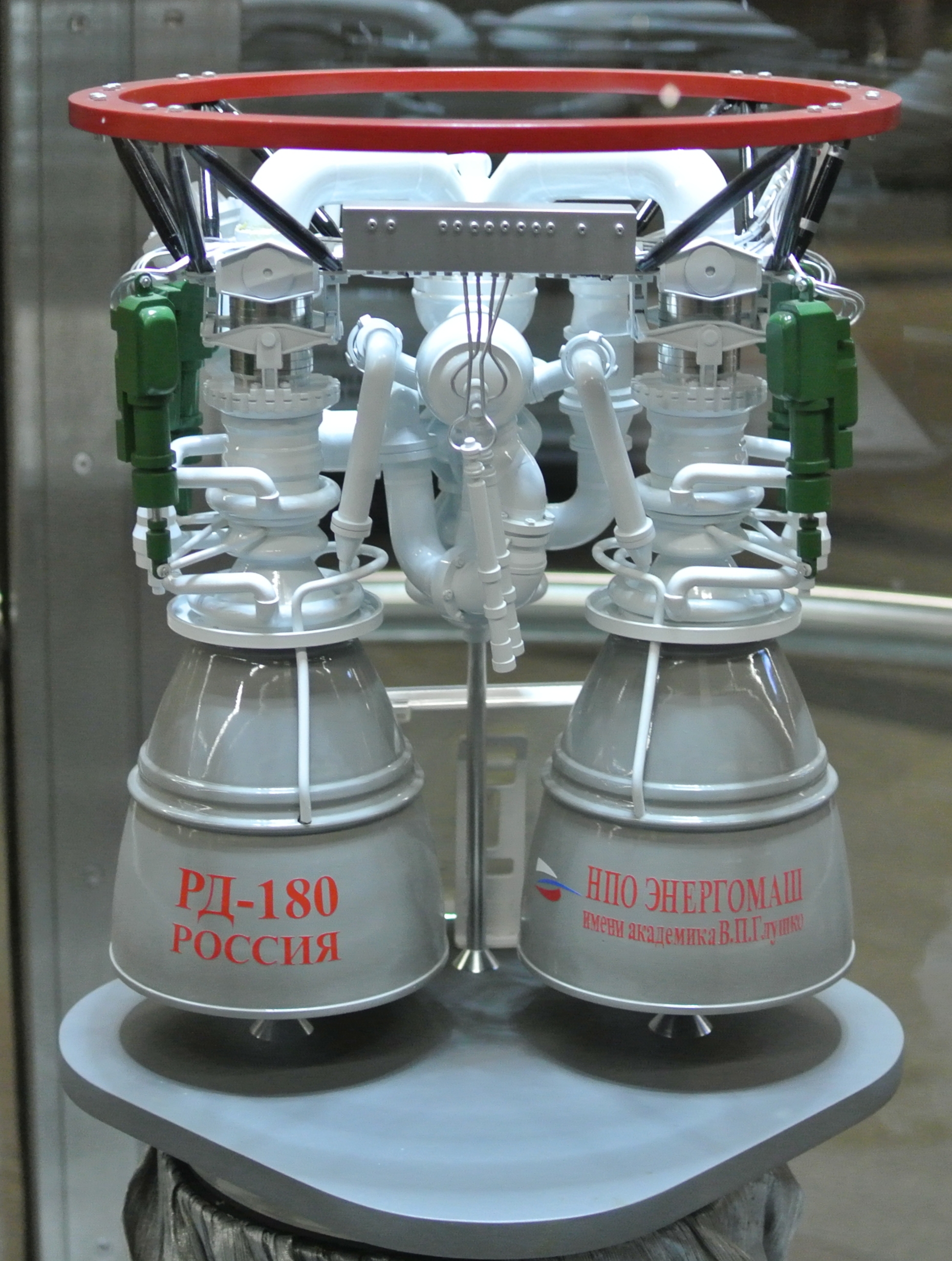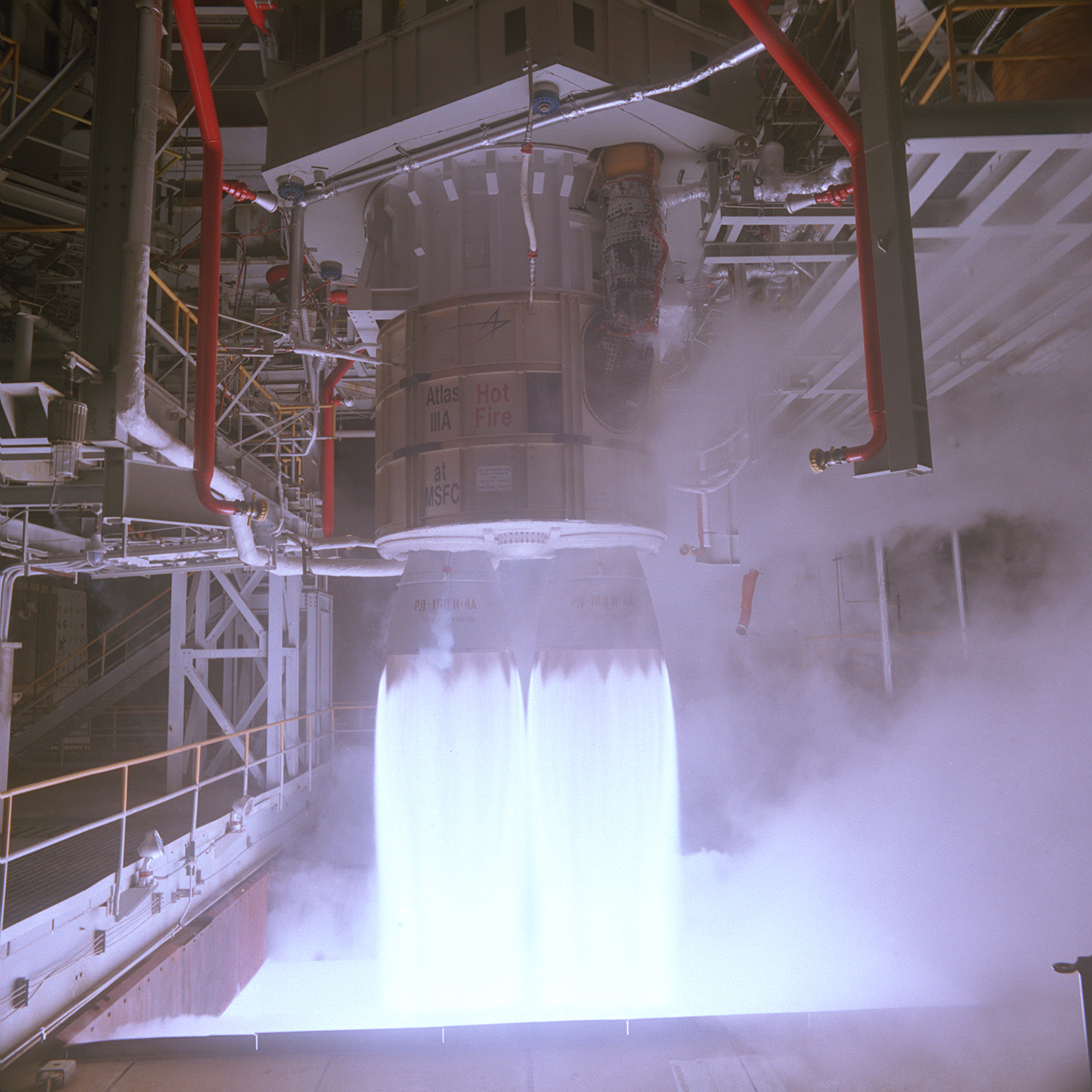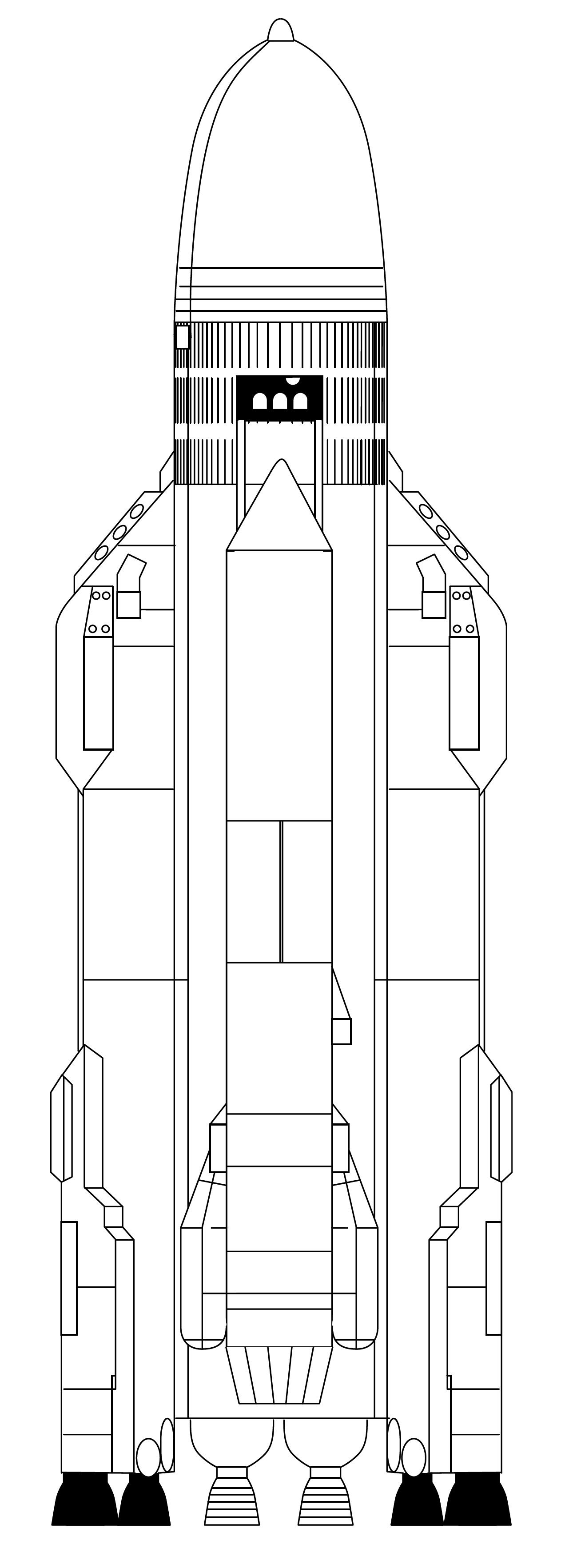|
RD-180
The RD-180 ( rus, РД-180, Ракетный Двигатель-180, Raketnyy Dvigatel-180) is a rocket engine designed and built in Russia. It features a dual combustion chamber, dual-nozzle design and is fueled by a RP-1/LOX mixture. The RD-180 is derived from the RD-170/RD-171 line of rocket engines, which were used in the Soviet Energia launch vehicle and are still in use in the Ukrainian Zenit launch vehicles. RD-180 engines are also used for the first stage of the American Atlas V launch vehicle, which is being phased out due to the national security implications of being reliant on foreign parts which became of concern after the Russian invasion of Crimea. , Russian supplies and maintenance have been discontinued as the result of trade sanctions caused by the 2022 Russian invasion of Ukraine. History The roots of the RD-180 rocket engine extend back into the Soviet Energia launch vehicle project. The RD-170, a four-chamber engine, was developed for use on the strap-o ... [...More Info...] [...Related Items...] OR: [Wikipedia] [Google] [Baidu] |
Atlas V
Atlas V is an expendable launch system and the fifth major version in the Atlas (rocket family), Atlas launch vehicle family. It was originally designed by Lockheed Martin, now being operated by United Launch Alliance (ULA), a joint venture between Lockheed Martin and Boeing. Atlas V is also a major NASA launch vehicle. It is America's longest-serving active rocket. In August 2021, ULA announced that Atlas V would be retired, and all 29 remaining launches had been sold. , 19 launches remain. Each Atlas V launch vehicle consists of two main stages. The first stage (rocketry), first stage is powered by a Russian RD-180 engine manufactured by NPO Energomash, Energomash and burning kerosene and liquid oxygen. The Centaur (rocket stage), Centaur upper stage is powered by one or two American RL10 engine(s) manufactured by Aerojet Rocketdyne and burns liquid hydrogen and liquid oxygen. The Star 48 upper stage was used on the ''New Horizons'' mission as a third stage. strap-on booster, ... [...More Info...] [...Related Items...] OR: [Wikipedia] [Google] [Baidu] |
United Launch Alliance
United Launch Alliance (ULA), legally United Launch Alliance, LLC, is an American spacecraft launch service provider that manufactures and operates a number of rocket vehicles that are capable of launching spacecraft into orbits around Earth, and to other bodies in the Solar System and beyond. The company, which is a joint venture between Lockheed Martin Space and Boeing Defense, Space & Security, was formed in December 2006. Launch customers of the United Launch Alliance include the Department of Defense (DoD), NASA, and other organizations. ULA provides launch services using expendable launch systems Delta IV Heavy and Atlas V, and until 2018 the medium-lift Delta II. The Atlas, Delta IV Heavy and the recently retired Delta IV launch systems have launched payloads including weather, telecommunications, and national security satellites, scientific probes and orbiters. ULA also launches commercial satellites. , the company is developing the Vulcan Centaur, a successor to the ... [...More Info...] [...Related Items...] OR: [Wikipedia] [Google] [Baidu] |
Staged Combustion Cycle (rocket)
The staged combustion cycle (sometimes known as topping cycle, preburner cycle, or closed cycle) is a Liquid-propellant rocket#Engine cycles, power cycle of a bipropellant rocket Rocket engine, engine. In the staged combustion cycle, propellant flows through multiple Rocket engine#Combustion chamber, combustion chambers, and is thus combustion, combusted in stages. The main advantage relative to other rocket engine power cycles is high fuel efficiency, measured through specific impulse, while its main disadvantage is reliability engineering, engineering complexity. Typically, propellant flows through two kinds of combustion chambers; the first called preburner and the second called main combustion chamber. In the preburner, a small portion of propellant, usually fuel-rich, is partly combusted, and the increasing volume flow is used to drive the turbopumps that feed the engine with propellant. The gas is then injected into the main combustion chamber and combusted completely with ... [...More Info...] [...Related Items...] OR: [Wikipedia] [Google] [Baidu] |
RD-170
The RD-170 ( rus, РД-170, Ракетный Двигатель-170, Raketnyy Dvigatel-170) is the world's most powerful and heaviest liquid-fuel rocket engine. It was designed and produced in the Soviet Union by NPO Energomash for use with the Energia launch vehicle. The engine burns kerosene fuel and LOX oxidizer in four combustion chambers, all supplied by one single-shaft, single-turbine turbopump rated at in a staged combustion cycle. Shared turbopump Several Soviet and Russian rocket engines use the approach of clustering small combustion chambers around a single turbine and pump. During the early 1950s, many Soviet engine designers, including Valentin P. Glushko, faced problems of combustion instability while designing bigger thrust chambers. At that time, they solved the problem by using a cluster of smaller thrust chambers. Variants RD-170 The RD-170 engine featured four combustion chambers and was developed for use on the Energia launch vehicle – both the eng ... [...More Info...] [...Related Items...] OR: [Wikipedia] [Google] [Baidu] |
Atlas III
The Atlas III (known as the Atlas II-AR (R for Russian) early in development ) was an American orbital launch vehicle, used in the years between 2000 and 2005. It was developed from the highly successful Atlas II rocket and shared many components. It was the first member of the Atlas family since the Atlas A to feature a "normal" staging method, compared to the previous Atlas family members, which were equipped with two jettisonable outboard engines on the first (booster) stage (with a single center engine serving as the sustainer). The Atlas III was developed further to create the Atlas V, which still flies to this day. Description The Atlas III was developed from the highly successful Atlas II rocket and consisted of two stages. The first stage was heavily modified from Atlas II and the upper stage remained the Centaur, which is still in use today on the Atlas V Evolved Expendable Launch Vehicle (EELV). The Atlas III was produced in two versions. The baseline was the Atla ... [...More Info...] [...Related Items...] OR: [Wikipedia] [Google] [Baidu] |
NK-33
The NK-33 and NK-43 are rocket engines designed and built in the late 1960s and early 1970s by the Kuznetsov Design Bureau. The NK designation is derived from the initials of chief designer Nikolay Kuznetsov. The NK-33 was among the most powerful LOX/RP-1 rocket engines when it was built, with a high specific impulse and low structural mass. They were intended for the ill-fated Soviet N1F moon rocket, which was an upgraded version of the N1. The NK-33A rocket engine is now used on the first stage of the Soyuz-2-1v launch vehicle. When the supply of the NK-33 engines are exhausted, Russia will supply the new RD-193 rocket engine. It used to be the first stage engines of the Antares 100 rocket series, although those engines are rebranded the AJ-26 and the newer Antares 200 and Antares 200+ rocket series uses the RD-181 for the first stage engines, which is a modified RD-191, but shares some properties like a single combustion chamber unlike the two combustion chambers used in the ... [...More Info...] [...Related Items...] OR: [Wikipedia] [Google] [Baidu] |
NPO Energomash
NPO Energomash “V. P. Glushko” is a major Russian rocket engine manufacturer. The company primarily develops and produces liquid propellant rocket engines. Energomash originates from the Soviet design bureau OKB-456, which was founded in 1946. NPO Energomash acquired its current name on May 15, 1991, in honor of its former chief designer Valentin Glushko. Energomash is noted for its long history of large scale LOX/Kerosene engine development. Notable examples are the RD-107/ RD-108 engines used on the R-7, Molniya and Soyuz rocket families, and the RD-170, RD-171 and RD-180 engines used on the Energia, Zenit and Atlas V launch vehicles. , the company remained largely owned by the federal government of Russia, but RSC Energia owned approximately 14% of the total shares. , NPO Energomash employed approximately 5500 workers at its headquarters in Khimki, Moscow and its satellite facilities in Samara, Perm, and St. Petersburg. On 4 August 2016, the company announced ... [...More Info...] [...Related Items...] OR: [Wikipedia] [Google] [Baidu] |
Energia (rocket)
Energia (russian: Энергия, Energiya, Energy; GRAU 11K25) was a 1980s super-heavy lift launch vehicle. It was designed by NPO Energia of the Soviet Union as part of the Buran programme, Buran program for a variety of payloads including the Buran (spacecraft), Buran spacecraft. Control system main developer enterprise was the Khartron NPO "Electropribor". The Energia used four strap-on boosters each powered by a four-chamber RD-170 engine burning kerosene/Liquid oxygen, LOX, and a central core stage with four single-chamber RD-0120 (11D122) engines fueled by liquid hydrogen/LOX. The launch vehicle had two functionally different operational variants: Energia-Polyus, the initial test configuration, in which the Polyus (spacecraft), Polyus system was used as a final stage intended to put the payload into orbit, and Energia-Buran, in which the Buran programme, ''Buran'' orbiter was the payload and the source of the orbit insertion impulse. The launch vehicle had the capacity to ... [...More Info...] [...Related Items...] OR: [Wikipedia] [Google] [Baidu] |
Marshall Space Flight Center
The George C. Marshall Space Flight Center (MSFC), located in Redstone Arsenal, Alabama (Huntsville postal address), is the U.S. government's civilian rocketry and spacecraft propulsion research center. As the largest NASA center, MSFC's first mission was developing the Saturn launch vehicles for the Apollo program. Marshall has been the lead center for the Space Shuttle main propulsion and external tank; payloads and related crew training; International Space Station (ISS) design and assembly; computers, networks, and information management; and the Space Launch System (SLS). Located on the Redstone Arsenal near Huntsville, MSFC is named in honor of General of the Army George C. Marshall. The center contains the Huntsville Operations Support Center (HOSC), also known as the International Space Station Payload Operations Center. This facility supports ISS launch, payload, and experiment activities at the Kennedy Space Center. The HOSC also monitors rocket launches from Cape ... [...More Info...] [...Related Items...] OR: [Wikipedia] [Google] [Baidu] |
Government Of Russia
The Government of Russia exercises executive power in the Russian Federation. The members of the government are the prime minister, the deputy prime ministers, and the federal ministers. It has its legal basis in the Constitution of the Russian Federation and the federal constitutional law "On the Government of the Russian Federation". The Apparatus of the Government of Russia is a governmental body which administrates the activities of the government. According to the 1991 amendment to the 1978 constitution, the President of Russia was the head of the executive branch and headed the Council of Ministers of Russia. According to the current 1993 constitution, the president is not a part of the government of Russia, which exercises executive power. However, the president appoints the prime minister. History The large body was preceded by Government of the Soviet Union. Since the Russian Federation emerged from 1991 to 1992, the government's structure has undergone several m ... [...More Info...] [...Related Items...] OR: [Wikipedia] [Google] [Baidu] |
Lockheed Martin
The Lockheed Martin Corporation is an American aerospace, arms, defense, information security, and technology corporation with worldwide interests. It was formed by the merger of Lockheed Corporation with Martin Marietta in March 1995. It is headquartered in North Bethesda, Maryland, in the Washington, D.C. area. Lockheed Martin employs approximately 115,000 employees worldwide, including about 60,000 engineers and scientists as of January 2022. Lockheed Martin is one of the largest companies in the aerospace, military support, security, and technologies industry. It is the world's largest defense contractor by revenue for fiscal year 2014.POC Top 20 Defence Contractors of 2014 . Retrieved: July 2015 In 2013, 78% of Lockheed Martin's revenues came from military sales; [...More Info...] [...Related Items...] OR: [Wikipedia] [Google] [Baidu] |
Kuznetsov Design Bureau
The Kuznetsov Design Bureau (russian: СНТК им. Н. Д. Кузнецова, also known as OKB-276) was a Russian design bureau for aircraft engines, administrated in Soviet times by Nikolai Dmitriyevich Kuznetsov. It was also known as (G)NPO Trud (or NPO Kuznetsov) and Kuybyshev Engine Design Bureau (KKBM). NPO Trud was replaced in 1994 by a Joint Stock Company (JSC), Kuznetsov R & E C. By the early 2000s the lack of funding caused by the poor economic situation in Russia had brought Kuznetsov on the verge of bankruptcy. In 2009 the Russian government decided to consolidate a number of engine-making companies in the Samara region under a new legal entity. This was named JSC Kuznetsov, after the design bureau. Products The Kuznetzov Bureau first became notable for producing the monstrous Kuznetsov NK-12 turboprop engine that powered the Tupolev Tu-95 bomber beginning in 1952 as a development of the Junkers 0022 engine. The new engine eventually generated about 15,000 horse ... [...More Info...] [...Related Items...] OR: [Wikipedia] [Google] [Baidu] |








